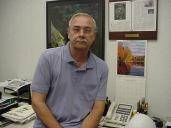
-----
How can I get 0.1nm surface roughness on Si surface?
Q. Dear Sir, I use single crystal silicon as substrate of laser mirror. I hope to get ultralow surface roughness. It is better at 0.1nm. Could you tell me where I can buy suitable polishing materials or how I can get 0.1nm surface roughness.Thank you.
Best regards
Sun Long- Dalian Inst. of Chem. Physics - Dalian, China
1999
i. Mr. Sun,
I do not think your requirement is realistic, as the size of an atom is in the range of 0.1nm. In other words, even if you put all the atoms of a material on an exact plane regardless of crystal structure, you will at least get 0.1nm surface roughness. The least surface roughness can be achieved by means of chemical mechanical polishing in semiconductor industry. This is a very hot area. Good luck.
Ling
Ling Hao- Grand Rapids, Michigan
i. Ling is correct that a 0.1nm surface roughness is state of the art in chemical-mechanical polishing. Wafer fabs spend millions for equipment and procedure development for this purpose. An RMS or Ra roughness of 0.3 to 0.5 nm is a typical goal for high-end polishing on silicon for sample analyzed in our lab.

Larry Hanke
Minneapolis, Minnesota
A. To polish silicon finer than 0.1nm surface roughness I would final polish on a 64 or 73 pitch lap. Use a colloidal silica that won't attack pitch such as Ultra-Sol 500S ND mixed 1/1 with de-ionized water. Keep pH up around 10-11.
Polishing pads don't bridge surface texture as well as a pitch lap will. You should be able to get your surface down to less than 5 angstroms RMS surface roughness using this process.
Robert Garfield- Pittsburgh, Pennsylvania, USA
2001
Q. Interesting. We sell CMP stainless steel sheets with Ra rating of 0.667 microinch (measured by white light interference microscope, AFM, SEM, etc.).
How does 0.667 microinch compare to 0.3 to 0.5 nm?

Michael Liu Taylor
specialty stainless steel distributor - Dallas, Texas
1999
A. Hi, Michael. Silicon wafers for laser mirrors must be far smoother than mirror polished stainless sheet. 0.667 microinch is 16.9 nanometers.
Regards,

Ted Mooney, P.E.
Striving to live Aloha
finishing.com - Pine Beach, New Jersey
Ted can be retained for immediate
answers or long term project help
Q. We have been trying to reach a roughness of under 0,4 nm. However, with the compounds at our disposal (Ultrasol 300), we can't seem to get under 0,4. We can get it slightly lower with softer pitch (22 to be exact), but that deteriorates the flatness way too much.
Is the difference between Ultrasol 500s and Ultrasol 300k that spectacular or is there something obvious we might be doing wrong?
- Oegstgeest, Zuid-Holland, Netherlands
March 19, 2012
A. This does not answer your question directly. A mechanical surface finish is a direct result of pressure and abrasive. When I say abrasive, particle size and hardness are major factors. If you include lubricants, this could have an effect on how the abrasive performs. So you may want to look for a different size media or abrasive hardness, or you can play with the pressure.

AF Kenton
retired business owner - Hatboro, Pennsylvania
April 9, 2012
![]() Thanks for the answer, more pressure seemed to do the trick.
Thanks for the answer, more pressure seemed to do the trick.
Need to run some more tests to be sure, but I'm down to 0,4 0,5 nm at the moment.
- Oegstgeest, Zuid-Holland, Netherlands
May 1, 2012
A. This thread intrigues me. I know very little about the surface of silicon, but I do know that 0.1nm is about the diameter of an atom, maybe even less than that, depending on the atom. Are we seriously talking about a surface where a couple of atoms out of place will put the surface out of specification? How do you measure these surfaces? I have used an AFM in my time, but do not consider it to be a piece of production control equipment.
If I am understanding the thread, once again, surface engineering is leading the way in surface sciences - we are now working at one thousandth the official definition of nanotechnology!
Maybe I need a course on silicon surface technology!

Trevor Crichton
R&D practical scientist
Chesham, Bucks, UK
May 31, 2012
Q, A, or Comment on THIS thread -or- Start a NEW Thread